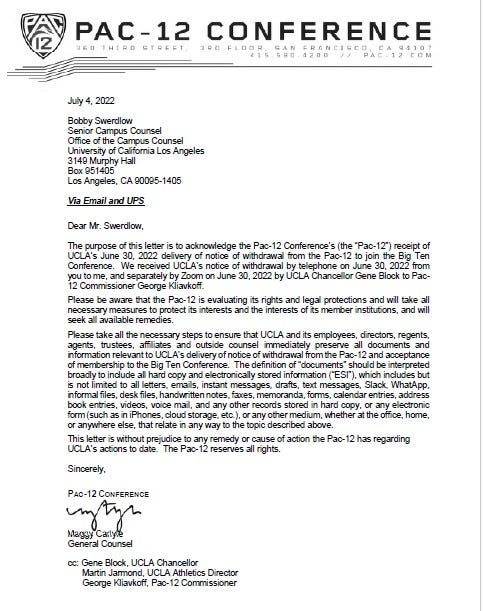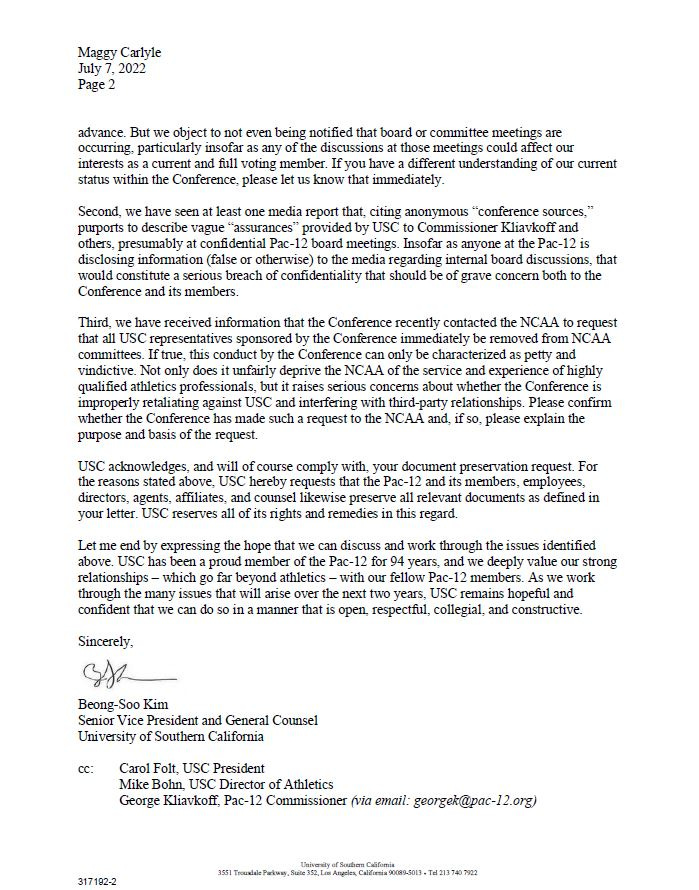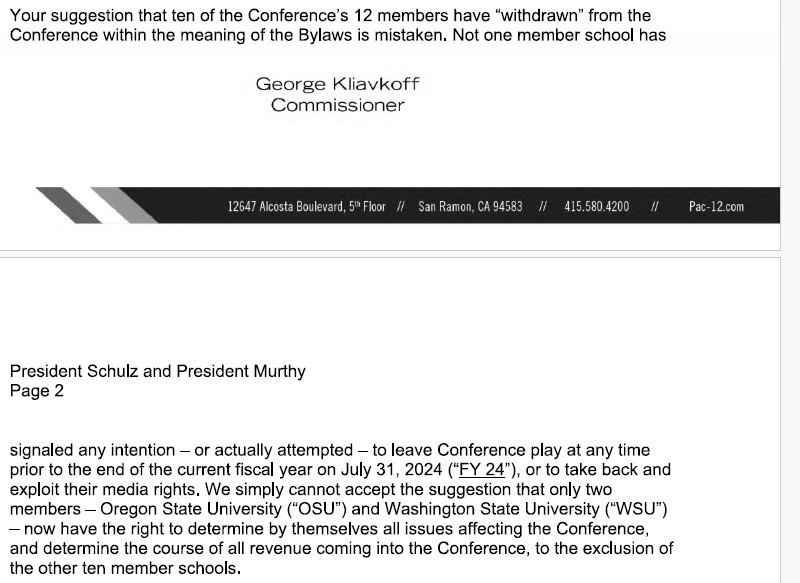WSU & OSU need political help for Pac 12 rebuild
Republished from BillFarley.net
The Key Issue
The issue at the heart of the lawsuit between WSU/OSU and the Pacific 12 Conference is the question; What constitutes a “Notice of Withdrawal” from the Conference prior to August 1, 2024? This determination is critical because Conference bylaws dictate that members providing such notice are no longer voting members.
The controversy over interpreting “Notice of Withdrawal” started quietly over a year ago when USC and UCLA advised the Conference administrators that they would be joining the Big 10 Conference after August 1, 2024. The Conference administrators took the position at that time that this was a “Notice of Withdrawal” and therefore USC and UCLA lost their voting rights (See Letter Below). USC and UCLA agreed to give up their vote under protest but reserved the right to contest the decision in the future (Letter from USC below). Both the Conference and the two schools then advised each other to retain all records relating to the matter in case of future legal challenges. At this point the conference likely felt on good ground because the remaining ten members had a super-majority (3/4 vote = 9/12 members) which could vote to revise the bylaws to clarify the definition of “Notice of Withdrawal” to fit the objectives the remaining members. In hindsight, it was a mistake for WSU and OSU not to press for such a vote.
Fast forward to July 27, 2023 and the University of Colorado announces it intends to leave the Pac 12 after August 1, 2024. In response to this announcement, the Conference advises Colorado that they also will no longer have a seat on the board. As with USC and UCLA, Colorado contested this interpretation of the bylaws and contended that they remained a member of the board. At this point the Conference still had a super majority that could add clarification to the bylaws to clearly exclude the three defectors from board decisions. Then, on August 4, 2023 six additional members announced they were leaving as well. Two of those universities, the University of Washington and University of Oregon, proactively sent letters to the Conference indicating they were not providing an official notice of withdrawal but indicated they would recuse from voting on adding Conference members or decisions that impacted the Conference after August 1, 2024.
After August 4, 2023 the Conference had four remaining members. This was enough to block a supermajority from dissolving the conference. Furthermore, NCAA bylaws permit a conference to rebuild membership over a two-year period to the required 8 members. The conference staff put together options to go forward with four members or dissolve. On September 1, 2023 Stanford and Cal advised the Conference they would be leaving the conference as well. The Conference now had more than a super majority that could vote to amend the bylaws to dissolve or strip the Conference of its assets. This would cripple WSU and OSU’s chance of taking advantage of the NCAA’s grace period.
The Conference shifted positions on interpreting the “Notice of Withdrawal” provision of the bylaws as the number of defectors grew (See Below for Court Filing). Now that the defectors are a super majority of the board, the Conference is aligned with their interests. You see the same shift in local government administrators as the make-up of their boards change. Administrators have to serve the majority of their board to remain employed. At first you lost your vote if you gave notice before August 1, 2024 that you were going to leave the conference at any point in the future. Now, you only lose your vote if you indicate you are moving to another conference and that the move will take place prior to August 1, 2024.
A Narrow Path
OSU and WSU are at a disadvantage now for several reasons, 1) a super majority is in place to dissolve or strip the conference assets, 2) the defecting members never stipulated to the Conference’s interpretation of the “Notice of Withdrawal” provision, 3) over the past year a super majority of the Conference membership did not amend the bylaws to clarify the condition under which a member forfeited their board seat, 4) there is no indication at this point that their sister universities will join the two in a voting block that could preserve the conference.
At this point, the best course of action for WSU and OSU appears to be 1) use legal channels to delay any vote of the full Conference membership, 2) Seek a settlement with the leverage that the discovery process for a trial could be damaging to some of the universities and the outgoing media partners, and 3) use political channels to have the University of Oregon and University of Washington join with them in a voting block that can thwart any votes to change the bylaws. It is a narrow path to succeed, and unless there is a quick lifeline from the Big 12, it could prove to be a very long one that could last well beyond this season.
(1) Conference tells UCLA they have given a Notice of Withdrawal (similar letter sent to USC)
(2) Letter from USC disputing Conference claim they gave up board seat.
(3) Court Filing: Conference position (a reversal) that no Universities have given Notice of Withdrawal
Excerpt of letter from Conference to WSU





